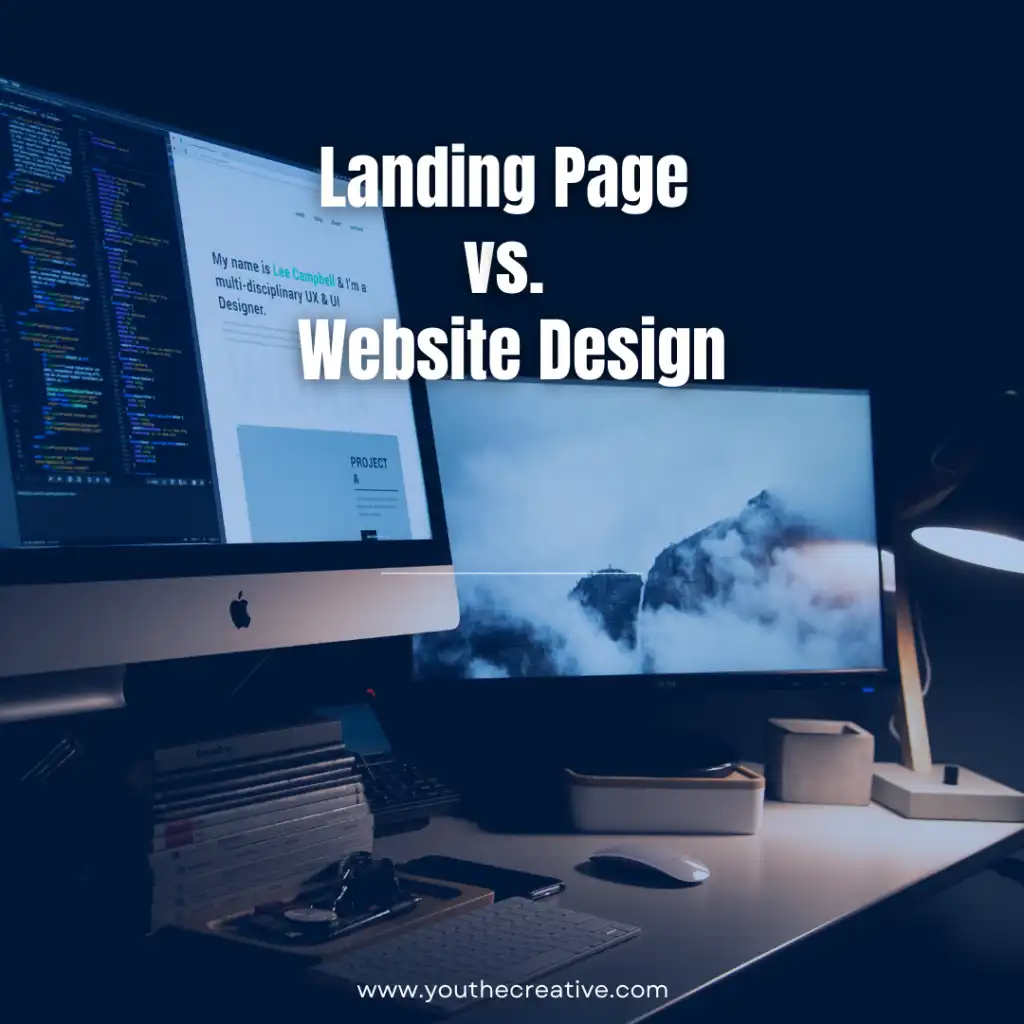Landing Page design is a subset of web design. A landing page is a single web page designed to convert a web visitor into a customer or subscriber. The purpose of a landing page is to convert or capture a user’s or potential customer’s interest and get them to take action to complete the desired objective.
A web page or website can have multiple purposes. A single web page can sell a product or service, collect leads, provide information, or promote an event. A website can also have multiple landing pages. For example, a single website can have a home page with multiple products or services that can be purchased, an event calendar, and an informational page or blog.
The objective of a landing page is to generate revenue or increase profit. Unlike a website with multiple purposes that may generate revenue, the objective of a landing page is singular.
What is Web Design?
Web design is the process of planning and creating websites, web applications, and digital documents for publication over the web. It uses various digital technologies and methods to create web content, applications, and documents.
When you build a website, you visually represent your organization or brand. You’re creating a visual representation of what you do, and you’re building a digital presence that can be seen and used by your target audience and potential customers.

The role of a web designer is to create the look and feel of your brand or organization’s website. A web designer is responsible for the visual design of a website. They’ll create the layout and design of a website but often will work separately from a web developer, who will build the site using code.
Web Design Methods
Professional web design is a broad category, and the practice generally covers various disciplines and skill sets. These days, web design is often done by user interface (UI) or user experience (UX) designers. These professionals typically handle both graphic design and information architecture. Graphic design is your website’s look, while information architecture addresses layout and organization.
Graphic designers use various tools, such as Adobe Photoshop and Illustrator, to create visual designs. These visual designs are then converted into code (such as HTML, CSS, and JavaScript) that the end user’s web browser can translate. The code is then uploaded to a web server where it can be viewed on a web browser.
User interface designers employ various software programs to create a website’s layout, structure, and navigation. These programs include Adobe XD, Sketch App, and countless others. The layout, structure, and navigation are also part of the code uploaded to the web server, along with the graphical and other media elements.
Web Design Tips and Best Practices
When creating a website, it’s important to remember that your website is not only about you. Your site should always be geared toward a positive user experience. It should be easy to navigate and understand. It should be visually pleasing, easy to navigate for users, and especially streamlined for customers and potential customers.
It’s also important to remember that you’re designing for the future. You should ensure that your website is mobile responsive, meaning that it displays well on any device, whether on a desktop computer, tablet, or mobile phone. This practice is known as “responsive design,” and it applies to landing pages.
What is Landing Page Design?

A landing page is a single webpage that serves as the entrance point to your website, application, or business. It’s the first page that visitors see and needs to make an impact on them quickly.
When creating a website, you’ll often have several pages designed for different purposes. For example, a single website can have a home page with multiple products or services that can be purchased, an event calendar, and an informational page or blog. On the other hand, a landing page is built to get visitors to take action, such as subscribing to your email newsletter or sign up for a free trial of your product or service.
Landing Page Design Methods
When creating landing pages, there are several different methods that you can use. You can use templates that CMS provides like WordPress. Or you can use pre-designed templates available for download on websites like ThemeForest or Creative Market. You can also build landing pages from scratch using HTML and CSS code.
The process you use to create a landing page depends on the type of landing page you’re creating. For instance, if you’re creating an eCommerce landing page, you might use a service specializing in eCommerce, like Shopify or BigCommerce, to build your landing page.
Landing Page Design Tips and Best Practices
Landing page design should focus on solving a problem that the visitor needs to solve quickly. This requires effective copywriting (generating the text appearing on the page) and conversion-centered design practices. There are many tools for measuring the success of a landing page, which are all dependent on the nature of the business and the solutions being offered.
Landing Page vs. Website Design: Key Differences

When it comes to designing websites and creating landing pages specifically, there are some key differences between the two:
1. Landing Pages Are Intended for One Purpose Only
The page’s objective must be clear and specific when you design a landing page. Unlike websites, where the objective can vary based on the site’s purpose, the objective for a landing page is singular and must be clearly defined from the start.
For example, suppose your goal is to collect leads for an upcoming product launch. In that case, you’ll need to create a landing page to collect potential buyers’ email addresses and contact information.
2. Landing Pages Should Be Easier to Understand and Navigate Than Websites
When you design your website, you need to make sure that it’s easy for visitors to navigate from one section of your website to another and find the information that they’re looking for as quickly and efficiently as possible.
However, when creating landing pages for your website, you need to take it one step further and ensure that your visitors can find what they’re looking for as quickly as possible. This means your visitors should be able to find what they’re looking for without having to scroll down several pages of content.
3. Landing Pages Should Have A Clear Call To Action
Websites often have various calls to action across several pages. However, with landing pages specifically, you want to ensure that your call-to-action (CTA) is clear and easy to find so that your visitors will know exactly what they’re supposed to do next. Without a clear CTA, leads are lost, and conversions remain unrealized.
4. Websites are Bigger in Size
Websites are typically much larger in size than landing pages. This makes sense because the purpose of websites is often more varied than the purpose of landing pages, meaning that websites need to accommodate more content than landing pages.
5. Websites Offer More Content Than Landing Pages Do
When you design your websites, you must ensure that you provide as much content as possible on each page so that your visitors have as many options as possible regarding what they’re looking at on each page. However, with landing pages specifically, you don’t want too much content on each landing page because it can overwhelm your visitors and prevent them from converting into customers or subscribers.
6. Websites Have a Longer Lifespan Than Landing Pages Do
Websites tend to live much longer than landing pages do because websites are typically designed with more longevity in mind than landing pages designed to be used for one specific event or campaign. However, when creating landing pages specifically for one-time events such as an upcoming product launch, you want to ensure that your visitors can find what they’re looking for without any problems so that they’ll be able to convert into customers or subscribers without any issues.
Landing Page vs. Website Design
Web design is constantly evolving, with new trends and techniques introduced daily. Online marketing brings with it new trends and techniques as well. As such, online marketers and web designers must stay up-to-date with all the latest trends and techniques in web design, whether applied to websites or landing pages.


Leave a Comment